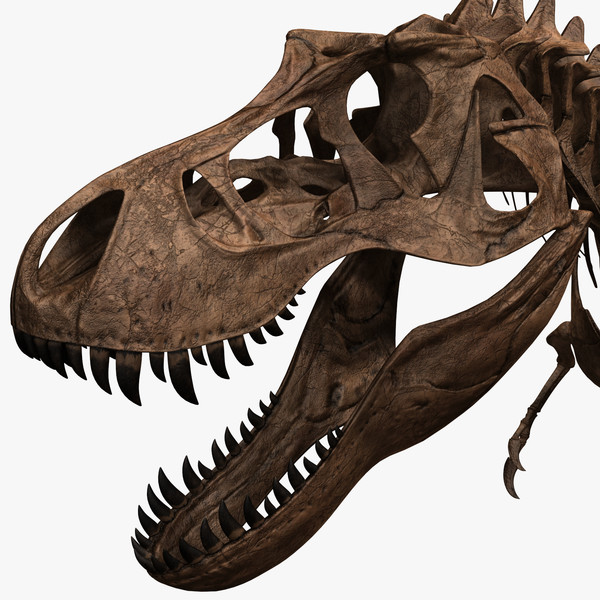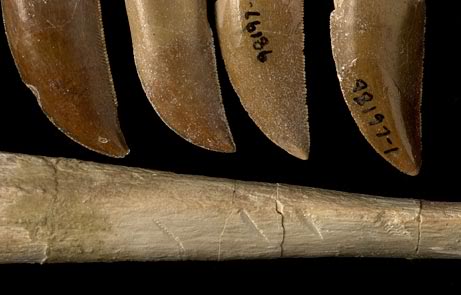Aug 22 2013
T-rex a Vegetarian?
 Creationists often have a flagrant disregard for the truth, at times to humorous effect. They often make claims that assault basic logic and common sense, let alone the scientific evidence. One such claim is the focus of a recent video uploaded to YouTube by Paul Taylor from Creation Today, in which he claims that Tyrannosaurus rex was a vegetarian.
Creationists often have a flagrant disregard for the truth, at times to humorous effect. They often make claims that assault basic logic and common sense, let alone the scientific evidence. One such claim is the focus of a recent video uploaded to YouTube by Paul Taylor from Creation Today, in which he claims that Tyrannosaurus rex was a vegetarian.
Let’s see if we can follow his tortuous logic.
He does acknowledge that T. rex looks like a creature that is supposed to have “et people.” Of course T. rex went extinct about 65 million years before people existed, but that’s a detail that seems to have escaped Taylor. As you will see, attention to detail is not something at which creationists excel.
Taylor further acknowledges that there is “circumstantial” evidence that T. rex may have eaten meat He refers to a triceratops fossil with a T. rex tooth mark, but is clearly minimizing the significance of this evidence as what he calls circumstantial.
He is not fairly representing the evidence, however. There is not one triceratops fossil with T. rex tooth marks, but many. A survey of triceratops fossils from the Hell Creek formation found 18 specimens with T. rex tooth marks. Further:
When they looked closer, they noted something important: none of the bones showed any signs of healing, indicating that the bites were inflicted on dead animals that were in the process of being eaten.
These specimens were not just killed by a single T. rex bite, or a pattern of bites indicating a battle, perhaps with the T. rex defending itself. The evidence suggests that T. rex routinely devoured triceratops. This is direct physical evidence, not circumstantial.
Taylor’s next argument is that scientists believe T. rex ate meat because of their sharp teeth. But, he counters, there are many creatures that eat plants that also have sharp teeth. He gives as examples pandas and the flying fox, which have sharp teeth for eating bamboo and melons respectively.
Here is where lack of attention to details bites Taylor in the backside yet again. Zoologists pay attention to the details of tooth anatomy and do not simply classify teeth as “sharp” or “not sharp.” Teeth can be short, long, flat, pointy, conical, straight, curved, smooth, or serrated (with different types of serrations for different materials). Teeth also differ in their placement with respect to each other (their dentition). Luckily there are thousands of different extant animal species with different diets and different teeth, so we have a huge data set to work from when determining the relationship between tooth anatomy and diet.
 T. rex teeth are not just “sharp” – they are long, curved, dagger-like, and serrated. They are optimized for slicing through flesh and tearing off pieces of meat. They are the teeth of carnivores. To compare them to herbivores with sharp teeth is absurd and requires willfully ignoring all the details of tooth and dentition anatomy.
T. rex teeth are not just “sharp” – they are long, curved, dagger-like, and serrated. They are optimized for slicing through flesh and tearing off pieces of meat. They are the teeth of carnivores. To compare them to herbivores with sharp teeth is absurd and requires willfully ignoring all the details of tooth and dentition anatomy.
Let’s take a look at his two examples, starting with the flying fox (there are at least 60 flying fox species, so not sure which one he is referring to).
Unlike the oblique shear of insectivore bats, or the antero-posterior shear of the carnivorous ghost bat, the basic flying fox molar pattern presents an outer and inner ridge separated by a shallow, rounded, longitudinal furrow.
The description highlights the differences in details of the tooth anatomy, indicating also that the flying fox teeth are optimized for squeezing the juice out of fruits (I could not find anything about tearing the flesh out of melons). They do have surprisingly large canines, but they are not optimized for tearing flesh. The are currently used for carrying away large fruit in their mouths, and perhaps were retained for this purpose.
The other example is the panda – a very problematic example to use. By multiple lines of evidence, pandas are part of the carnivora order of mammals. Pandas have a recent carnivorous ancestor, and only recently adapted to eating bamboo shoots. They still retain a dentition more characteristic of carnivores, therefore.
It’s interesting that Taylor presents this as if it is somehow a problem for “evolutionists.” Quite the contrary – evolution provides a nice explanation backed by evidence for the apparent mismatch between the panda’s teeth and their diet. It is the creationists who have the real problem explaining this.
All of this information about the relationship between dentition and diet is readily available on the internet, but apparently Taylor did not see the need to avail himself of this information or consult with actual experts. He was content to spout dubious factoids that superficially seem to support his position.
And what is his point, exactly? Why would creationists go through so much trouble trying to make the ridiculous argument that T. rex were herbivores? Well, when God created the earth, everything was a perfect paradise. Animals lived in harmony and only ate plants. Therefore all animals were created by God to eat plants. It is only after the fall of Adam and Eve that God cursed the earth and some animals starting eating other animals.
What this means is that all adaptations for eating other creatures (from a spider’s web to a tiger’s claws) and all defenses against being eaten developed after the fall. I wonder what an herbivorous cheetah looked like. Maybe they were built for chasing down those famous flying bushes of the Serengeti. Further – T. rex must have been created to be an herbivore.
When you start with unshakable tenets of faith, there are no limits to the logical knots in which you can tie yourself to maintain your premise in the face of contradictory evidence.






